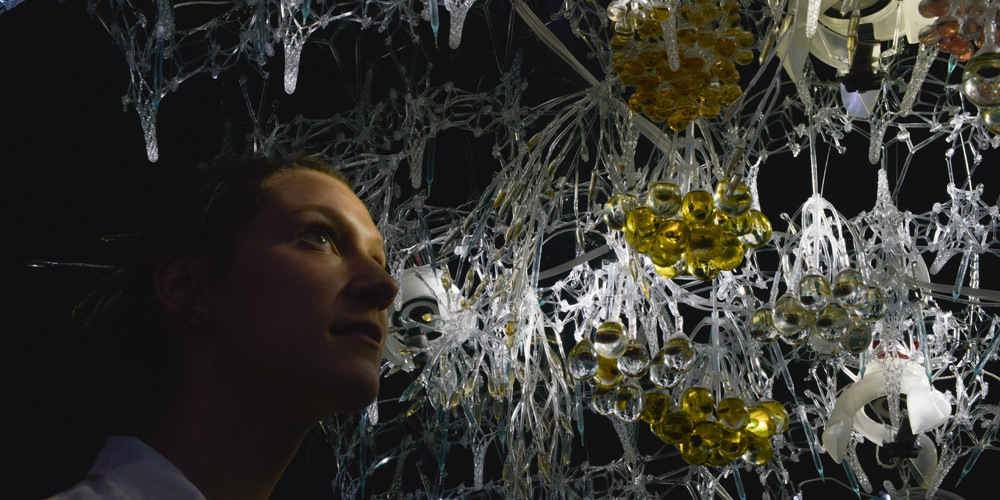Honorary Mention
Sentient Veil is a jewel-like canopy containing multiple miniature sound processors interwoven with hundreds of digitally controlled lights installed within the historic galleries of the lsabella Stewart Gardner Museum. The work pursues intimacy and sensitivity through intricate miniature components and layers of diffusive, hovering material close to the scale of a human body. Sentient Veil is composed of digitally fabricated cellular textile lining floating over the ceiling surface of the gallery. The work is composed of finely detailed interlinking skeletal components containing distributed computational controls with soft LED lighting and whispering interactive sound functions. Movement of visitors within the space triggers choruses of whispering responses emanating from miniature custom acoustic resonators integrated within the fabric of the sculpture. Glass vessels containing chemical protocells and carrying interactive LED lighting are also integrated within the sculpture.
The work contains textile-like details that respond to iconography within a religious painting by the 15th-century ltalian master Fra Angelico, located within an adjacent gallery. A direct dialogue with adjacent paintings, where the hybrid new fabric of the sculpture, carrying ambivalent, alien synthetic qualities, resonates and enriches the subtle meanings of traditional fabrics seen within the painting of nearby masters.
Hardware
Sentient Veil’s structure is composed of thermally expanded and laser cut acrylic diagrid spars that provide substantial strength while at the same time retaining flexibility, suggesting that the structures are capable of handling architectural-scale forces. Tensegrity coupling is featured, employing metal rod cores that stabilize the system. This structure offers minimal material consumption. Borosilicate glass and Mylar populate the acrylic canopy, adding density. Embedded within this structure are distributed infrared sensors that sense external movement generated by the audience as well as its own internal actions. These sensor networks provide feedback between controls and kinetic mechanisms while generating kinetic movement in actuators. Modulation systems in the environment are controlled by Teensy boards running off of the popular open source Arduino platform. Fed by data received from sensors, these customdesigned boards in turn communicate over custom-designed cabling, while running the software that generates complex behavior in actuators. The combination of computational and physical systems creates substantial complexity and unpredictability. For example, interactions with sensors at one location influence the behaviors of actuators both locally and globally.
Software
Sentient Veil’s software is structured as a modular hierarchy, consisting of a low-level layer and a high-level layer. The two layers are connected physically through USB. A low-level layer of firmware written in C++ runs on Teensy 3.2 USB-based development boards, which interface with peripheral boards connected to actuators and sensors. High-level software written in Python runs on a Raspberry Pi that provides flexibility for development, free from the limited processing power inherent to the Teensy microcontrollers. Software controls the interactive components of the installation including interactive LEDs and soundscapes.
Credits
Photo: PBAI
Sentient Veil by Philip Beesley
Philip Beesley Studio: Gabriella Bevilacqua, Adam Francey, Joey Jacobson, Nicole Jazwiec, Salvador Miranda, Reza Nik, Jordan Prosser, Filip Vranes
Collaborators: Augmented Reality: Katy Borner, Andreas Bueckle
Engineering: Rob Gorbet, David Kadish, Dana Kulic,
Sound Design: Alex Young
Sponsors: Social Sciences and Humanities Research Council, University of Waterloo
Philip Beesley (CA) is a practising visual artist, architect, and Professor in Architecture at the University of Waterloo. Beesley’s work is widely cited in contemporary art and architecture, focused in the rapidly expanding technology and culture of responsive and interactive systems. His Toronto-based practice, Philip Beesley Architect lnc., combines the disciplines of professional architecture, science, engineering, and visual art. The studio’s methods incorporate industrial design, digital prototyping, instrument making, and mechatronics engineering.
Jury Statement
Philip Beesley has succeeded in composing layers of cellular textiles, a multitude of LED lights, and glass vessels containing chemical photocells glimmering in color, into generic beauty. Looking at this work, one imagines the experience as being akin to walking into an ancient dreamy forest, and like such forest, it recognizes you, hissing, breathing, and groaning. The jury appreciated this work for its combination of intricate technology and strong yet elegant aesthetics; a thought provoking installation that invites us to ponder about our most elemental state of being.



